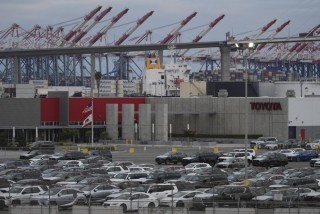Loading
Search
▼ Trump's Lowered 15% Tariff On Cars From Japan To Take Effect Tuesday
- Category:Other
U.S. President Donald Trump's lowered tariff of 15 percent on automobiles from Japan will take effect Tuesday, the Commerce Department said, about five months after his aggressive trade agenda began to heavily impact the industrial backbone of one of Washington's key allies.
The department announced the timing of the adjustment on Monday. After Trump imposed an additional auto tariff on national security grounds in April, the U.S. tariff rate for foreign-origin cars rose from 2.5 percent to 27.5 percent, squeezing the margins of Japanese automakers and other manufacturers.
The reduced tariff is part of a trade deal the Trump administration struck on July 22 with Japan, which in return has committed to investing massively in the United States and increasing imports of American agricultural products during the president's nonconsecutive second term.
Although the implementation of the lowered auto tariff will ease the impact on Japan's automotive sector, the 15 percent rate remains far higher than before and continues to weigh heavily on carmakers and related industries.
Trump signed an executive order on Sept. 4 formally implementing the trade agreement, which also granted Japan special treatment on what he calls "reciprocal" tariffs.
The department's notice to be published Tuesday said that as agreed by the two countries, Trump's additional 25 percent tariff imposed in May on major auto parts, including engines and transmissions, will also be cut to 15 percent for those coming from Japan.
The guidance further specified that civil aircraft and aircraft parts of Japan will no longer be subject to additional U.S. tariffs.
In 2024, Japan exported around 6 trillion yen worth of vehicles to the United States. Together with auto-parts exports, they accounted for one-third of Japan's total shipments to the world's largest economy, according to Japanese trade data.
The United States has agreed to grant the same tariff rate for automobiles from the European Union and South Korea as it does for Japan. The United States has reduced its tariff on British cars to 10 percent for up to 100,000 units annually.
On Aug. 7, Trump's modified country-specific tariff rates for goods from dozens of U.S. trading partners came into effect.
The United States currently imposes a 15 percent tariff on most imports from Japan, down from the 24 percent or 25 percent that Trump had threatened prior to the agreement.
Additionally, his trade team has agreed that imports from Japan with preexisting tariffs of 15 percent or higher will not face any additional duty, and levies on other goods will be capped at 15 percent.
However, the United States had yet to implement either the lowered auto tariff rate or the "no stacking" treatment for Japan.
The executive order, followed by necessary administrative procedures, finally enabled the United States to put the two commitments into practice.
With respect to any excess stacking tariffs collected from importers of Japanese goods under its new country-by-country tariff system, the Trump administration has said it will refund them dating back to Aug. 7.
The department announced the timing of the adjustment on Monday. After Trump imposed an additional auto tariff on national security grounds in April, the U.S. tariff rate for foreign-origin cars rose from 2.5 percent to 27.5 percent, squeezing the margins of Japanese automakers and other manufacturers.
The reduced tariff is part of a trade deal the Trump administration struck on July 22 with Japan, which in return has committed to investing massively in the United States and increasing imports of American agricultural products during the president's nonconsecutive second term.
Although the implementation of the lowered auto tariff will ease the impact on Japan's automotive sector, the 15 percent rate remains far higher than before and continues to weigh heavily on carmakers and related industries.
Trump signed an executive order on Sept. 4 formally implementing the trade agreement, which also granted Japan special treatment on what he calls "reciprocal" tariffs.
The department's notice to be published Tuesday said that as agreed by the two countries, Trump's additional 25 percent tariff imposed in May on major auto parts, including engines and transmissions, will also be cut to 15 percent for those coming from Japan.
The guidance further specified that civil aircraft and aircraft parts of Japan will no longer be subject to additional U.S. tariffs.
In 2024, Japan exported around 6 trillion yen worth of vehicles to the United States. Together with auto-parts exports, they accounted for one-third of Japan's total shipments to the world's largest economy, according to Japanese trade data.
The United States has agreed to grant the same tariff rate for automobiles from the European Union and South Korea as it does for Japan. The United States has reduced its tariff on British cars to 10 percent for up to 100,000 units annually.
On Aug. 7, Trump's modified country-specific tariff rates for goods from dozens of U.S. trading partners came into effect.
The United States currently imposes a 15 percent tariff on most imports from Japan, down from the 24 percent or 25 percent that Trump had threatened prior to the agreement.
Additionally, his trade team has agreed that imports from Japan with preexisting tariffs of 15 percent or higher will not face any additional duty, and levies on other goods will be capped at 15 percent.
However, the United States had yet to implement either the lowered auto tariff rate or the "no stacking" treatment for Japan.
The executive order, followed by necessary administrative procedures, finally enabled the United States to put the two commitments into practice.
With respect to any excess stacking tariffs collected from importers of Japanese goods under its new country-by-country tariff system, the Trump administration has said it will refund them dating back to Aug. 7.
- 16/9 20:37
- Comment (0)
- Trackback(0)


